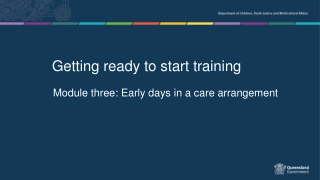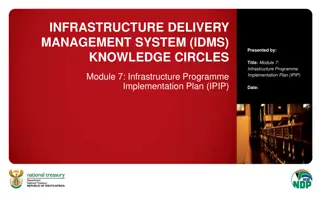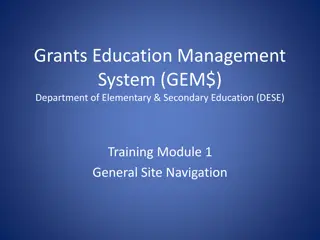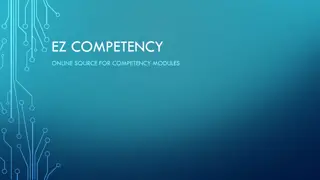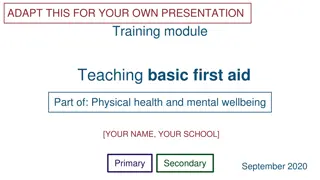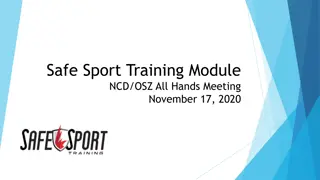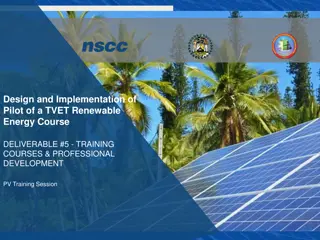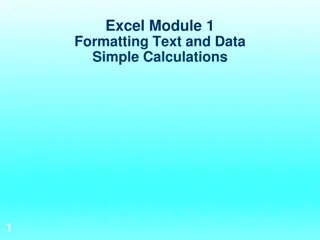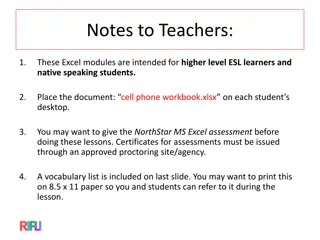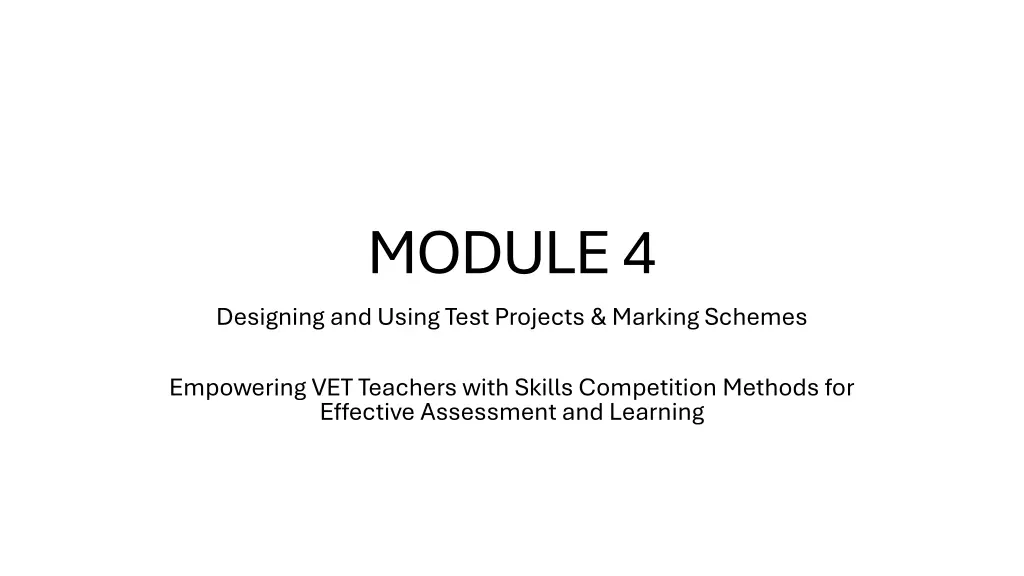
Understanding WorldSkills Assessment Tools for VET Teachers
Explore the significance of WorldSkills assessment tools like Test Projects and Marking Schemes for Vocational Education and Training (VET) teachers. Discover how these tools align with industry needs and enhance teaching and learning.
Download Presentation

Please find below an Image/Link to download the presentation.
The content on the website is provided AS IS for your information and personal use only. It may not be sold, licensed, or shared on other websites without obtaining consent from the author. If you encounter any issues during the download, it is possible that the publisher has removed the file from their server.
You are allowed to download the files provided on this website for personal or commercial use, subject to the condition that they are used lawfully. All files are the property of their respective owners.
The content on the website is provided AS IS for your information and personal use only. It may not be sold, licensed, or shared on other websites without obtaining consent from the author.
E N D
Presentation Transcript
MODULE 4 Designing and Using Test Projects & Marking Schemes Empowering VET Teachers with Skills Competition Methods for Effective Assessment and Learning
1. Orientation to the WorldSkills Assessment Ecosystem Objectives: Understand the educational value of WorldSkills assessment tools Recognize the link between the WSOS, Test Project, and Marking Scheme Content: Purpose of Test Projects & Marking Schemes The WorldSkills Assessment Life Cycle Why these tools matter for all VET students not just competitors Activity: Compare national exam practices to WS assessment principles Resource: WS Assessment Life Cycle diagram
Why Are We Talking About WorldSkills? WorldSkills is more than a competition it s a global benchmark of vocational excellence Tools used in WS (Test Projects, Marking Schemes, Standards) are: Practical Competency-based Aligned to industry needs These tools can enhance day-to-day VET teaching and learning
Test Project = Assessment Vehicle A Test Project is a task or set of tasks task or set of tasks that simulate real workplace scenarios scenarios real workplace Purpose: to measure how well students perform measure how well students perform compared to international standards Not about rote knowledge, but about doing doing: skills, decisions, and execution Think of it as: What would a top-performing young professional do in this situation?
Marking Scheme = Feedback & Scoring Tool A Marking Scheme (MS) defines how performance is assessed how performance is assessed Based on: Sub Sub- -criteria Measurement Measurement (objective) & Judgement criteria and aspects aspects Judgement (subjective with standards) It ensures fairness, consistency, and transparency fairness, consistency, and transparency Without an MS, a task is just an activity. With an MS, it's a learning and assessment tool learning and assessment tool.
The Triangle of Excellence WSOS (Standard) Test Project (Task) Marking Scheme WSOS (Standard) Test Project (Task) Marking Scheme (Assessment) (Assessment) Each Test Project and Marking Scheme must align with the WorldSkills Occupational Standards WorldSkills Occupational Standards (WSOS) or with the national standard, which define: Skills Knowledge Behaviours This triangle ensures: relevance, rigour, and reliability
WorldSkills Assessment Life-Cycle Six key phases in the WS assessment process: 1. 1.Referencing Referencing: using WSOS (or the national standard) to define what s assessed 2. 2.Design Design: selecting suitable tasks & methods 3. 3.Development Development: building the Test Project & Marking Scheme 4. 4.Preparation Preparation: logistics, tools, trials 5. 5.Implementation Implementation: actual assessment during competition/training 6. 6.Review Review: data analysis, improvement, and feedback
Who Benefits from These Tools? Not only competitors! Not only competitors! VET teachers can use TPs/MS in: Classroom projects Practical exams Self/peer assessments Students benefit from: Industry-relevant, realistic learning Clear expectations and standards Formative feedback aligned with workplace demands
WorldSkills Assessment Principles Each assessment must be: Valid Valid measures what it should Reliable Reliable consistent, repeatable Fair Fair unbiased, inclusive Transparent Transparent clear process & expectations Authentic Authentic based on real work tasks
How This Helps You as a VET Teacher Adds structure and clarity clarity to performance assessment Encourages competency competency- -based teaching based teaching Gives access to ready ready- -made professional materials made professional materials Fosters curiosity and confidence curiosity and confidence in students Creates a bridge between school and industry school and industry
Quick Check: Discussion or Reflection In your current teaching, what are some challenges you face when assessing practical skills? Discuss in pairs or small groups Link your reflections to the WS approach you ve seen today
Summary Test Projects = authentic tasks Marking Schemes = structured assessment & feedback Together, they align with WSOS and support powerful, practice- based learning Next up: How to Design a Test Project How to Design a Test Project Let s build one from scratch!
2. Building Blocks of a Test Project Objectives: Learn how to design Test Projects aligned with the WSOS Understand how to define skills-based challenges that assess both hard and soft skills Content: Types of Test Projects: full, modular, speed test (15 30 min), scenario- based Linking tasks to WSOS: authenticity, relevance, and coverage Time and resource feasibility Validation process and quality assurance of TPs Activity: Draft a mini Test Project for a module you teach Example: Speed test format (e.g., from Web Technologies Skill 17)
What is a Test Project? A Test Project (TP) Test Project (TP) is: A realistic, hands-on task used to assess skills performance Based on actual workplace roles and industry practices Linked to a standard (WSOS, national curriculum, or occupational profile) A tool for assessment assessment, learning learning, and feedback feedback
Purpose of a Test Project A good Test Project: Simulates authentic tasks from a profession Covers key skills, knowledge, and behaviours Offers fair, standard-based assessment opportunities Can be used for both competition and regular teaching In the classroom, it becomes a competence experience experience competence- -oriented learning oriented learning
Test Project Formats WorldSkills uses flexible formats. You can too. Modular Modular each task focuses on a specific skill area Integrated Integrated combines multiple competencies into one product Speed Test Speed Test short challenges assessing precision or fluency (15 30 min) Scenario Scenario- -based based simulates a client, situation, or emergency These formats are adaptable for subjects like: Carpentry (e.g. building a joint) Hospitality (e.g. preparing a table for two dietary requirements) Nursing (e.g. administering basic patient care in a simulation)
Core Elements of a Test Project Every Test Project should clearly define: Context Context What is the professional situation? Task Task What is the student expected to do or produce? Time Limit Time Limit How much time is available? Materials & Tools Materials & Tools What s provided and what must be used? Expected Outcome Expected Outcome What does success look like? Skills/competencies assessed Skills/competencies assessed Linked to learning goals or a standard
Aligning TPs with Standards To ensure quality, align Test Projects with one or more of the following: WorldSkills Occupational Standards (WSOS) or the national WorldSkills Occupational Standards (WSOS) or the national standards standards National Qualifications Frameworks National Qualifications Frameworks Industry standards or job profiles Industry standards or job profiles Curriculum learning outcomes Curriculum learning outcomes This ensures the task reflects real expectations and is relevant for the learner's development.
Writing an Effective Task Good task design includes: A clear goal: Install a basic lighting circuit in a simulated home environment. Realistic conditions: You are working in a customer s home with limited tools. Constraints: You must follow safety rules and finish in 60 minutes. A tangible outcome: The light turns on safely and cleanly. Avoid vague tasks. Make them purposeful and job-like.
Tips for Classroom Adaptation VET teachers can adjust WS-style Test Projects by: Reducing complexity Breaking tasks into stages Providing more instructions or support Extending time Allowing team work if appropriate Focusing on learning process, not just the final product Even.small? .adapted.tasks.can.build.real.confidence.and.competence.
Quality Assurance in WS TPs In WorldSkills, every Test Project is: Reviewed by Experts Validated to ensure time, tools, and safety are realistic Aligned with the WSOS and assessment strategy Piloted or tested before use In VET, this can translate to: Peer review by colleagues Informal trials with students Curriculum mapping
Create a Mini Test Project Design a task in your subject area that includes: 1.Professional context (who, where, why?) 2.Clear task description 3.Tools/materials available 4.Time limit 5.Expected output 6.Link to a curriculum or occupational standard 20 30 minutes. Share your draft with a peer for feedback.
Summary A Test Project is a structured, realistic task that mirrors industry practice It can be adapted for any VET subject It helps assess applied competence not just knowledge It must be clear, fair, and aligned with standards You can start small and grow your toolkit Next: Designing the Marking Scheme Designing the Marking Scheme how do we assess this performance? performance? how do we assess this
3. Designing a Marking Scheme Objectives: Understand the structure and types of Marking Schemes (judgement & measurement) Be able to create a simplified Marking Scheme Content: What is a Marking Scheme and what it includes Sub-criteria, Aspects, and benchmark descriptors Use of 0 3 scale in judgement; precision in measurement Consistency, reliability, and validation rules Activity: Create 6 aspects for a sample task using both judgement and measurement Tools: Blank Marking Scheme Template, Sample from WSC2024 Skill 17
What is a Marking Scheme? A Marking Scheme Marking Scheme is the tool used to: Define what is being assessed Define what is being assessed Assign value Assign value to each aspect of performance Ensure consistency Ensure consistency among assessors Provide feedback Provide feedback to students Connect the task to learning outcomes or standards Connect the task to learning outcomes or standards It transforms observation into evaluation.
Core Components of a Marking Scheme Each WS-style Marking Scheme includes: 1. 1.Assessment Criteria Assessment Criteria broad performance areas (e.g., accuracy, safety, aesthetics) 2. 2.Sub Sub- -criteria criteria more detailed groupings within each area 3. 3.Aspects Aspects specific, assessable items 4. 4.Assessment Method Assessment Method Measurement or Judgement 5. 5.Score Scale Score Scale points or levels (e.g., 0 1, 0 3) 6. 6.Benchmark Descriptors Benchmark Descriptors what each score means
Assessment Methods Measurement Measurement Objective. Based on fact. Yes or No Dimensions, accuracy, quantity, presence Used when outcome is clear and binary Example: Is.the.hairdryer.working.properly? Is.the.electrical.circuit.correctly.wired? Judgement Judgement Subjective (with clear standards). Based on performance quality Scale: 0 = not achieved, 3 = excellent Example: How.well.is.the.wood.surface.finished? How.creatively.did.the.student.solve.the.problem?
Judgement: The 03 Scale WorldSkills uses a 0 3 scoring scale for Judgement: 0 0 = Below standard (unacceptable or missing) 1 1 = Acceptable (meets minimum requirements) 2 2 = Good (above expectations in some ways) 3 3 = Excellent (fully exceeds industry standard) For each level, you must write clear descriptors can score consistently. clear descriptors so assessors
Example Aspect with Judgement Descriptors Aspect: Aspect: Customer interaction during service delivery Criteria: Criteria: Communication & Professionalism Judgement Scale ( Judgement Scale (0 0 3 3): ): Score Score Descriptor Descriptor 0 Did not greet or explain service. No eye contact. 1 Greeted customer but lacked clarity and engagement. 2 Clear explanation, polite tone, moderate engagement. 3 Professional greeting, confident explanations, empathetic interaction. Helps all assessors interpret and score performance the same way.
Measurement Marking Example Aspect: Aspect: The item weighs exactly 100g 2g Criteria: Criteria: Accuracy Max score: Max score: 1 mark Score 1 0 Condition Weight is within range (98 102g) Outside the acceptable range No.interpretation.required. .it s.either.correct.or.not.
Designing a Simple Marking Scheme Let s say you created a task: "Prepare.and.serve.a.non-alcoholic.cocktail.with.proper. hygiene.and.presentation" You could assess it like this: Criterion Aspect Hygiene & Safety Hands and workstation sanitized Preparation Ingredients correctly measured Presentation Visual appeal of the drink Communication Described the drink to the client Method Measurement Measurement Judgement Judgement Max score 1 1 0-3 0-3 Total: 8 marks
Ensuring Consistency & Fairness To make sure your Marking Scheme works: Use clear, detailed descriptors clear, detailed descriptors Avoid vague or personal interpretations Ensure compatibility with Test Project goals compatibility with Test Project goals Provide assessor training assessor training if working in a team Consider peer review of your Marking Scheme before use Consistency builds trust in your assessments.
Summary Marking Schemes make assessment structured, transparent, and fair Use Measurement Measurement when possible, Judgement Good descriptors = consistent results Teachers can adapt this model to assess skills in any VET subject The Marking Scheme must match both the task standard standard Next: Using Test Projects & Marking Schemes for Teaching, Using Test Projects & Marking Schemes for Teaching, Feedback, and Motivation Feedback, and Motivation Judgement when necessary task and the
4. How to Use TPs & Marking Schemes in Teaching & Learning Objectives: Objectives: Integrate WS-style assessments into curricula Use them to track and enhance student learning Content: Content: Classroom implementation: formative vs. summative Using the TP/MS to provide feedback and track progress Peer- and self-assessment models Connecting assessment with feedback, motivation, and learning pathways Activity: Pilot and peer-review a WS-style mini-module in your class Deliverable: Plan to implement one WS-style assessment unit per semester
From Competition to Classroom WorldSkills tools are not only for competitors. They help teachers: Define clear performance goals Observe practical skills in structured ways Give meaningful feedback Track progress over time Prepare students for real-world jobs and national assessments
Key Applications in Teaching Formative Assessment Formative Assessment Use parts of a Test Project to check progress Apply judgement marking for peer/self-assessment Summative Assessment Summative Assessment Use a full TP + MS for exams or final projects Provide scores and qualitative feedback Project Project- -Based Learning Based Learning Use integrated TPs to simulate workplace tasks Involve planning, execution, and reflection
Benefits for Students Understand what Practice real Receive concrete feedback concrete feedback they can act on Build confidence and own their progress See how their skills connect to jobs and careers what s expected s expected at professional level real- -life tasks life tasks in a safe, structured environment own their progress
Feedback = Learning The Marking Scheme is not just for grading it s a tool for feedback. Use descriptors to explain scores Focus on strengths and improvement areas Ask students to reflect: What went well? What could be improved? What will I do differently next time? Feedback transforms assessment into a growth experience.
Differentiating for All Learners You can adjust WS tasks and marking for different learner levels: Beginners Beginners Use simplified tasks and fewer criteria Provide exemplars and support materials Intermediate Intermediate Introduce full Judgement scale (0 3) Encourage peer assessment Advanced Advanced Use real client scenarios Integrate multiple skills in one TP Invite industry feedback
Promoting Self-Assessment & Ownership Teach students to use the MS themselves: Ask them to mark their own work Pair students to mark each other Let them compare against rubrics Use their reflections to guide individual learning plans This builds metacognition and prepares them for lifelong learning.
Data-Driven Improvement When using TPs & MS regularly, you generate useful data: Track class-wide trends Identify recurring gaps Adjust your curriculum or teaching focus Share examples of excellence and growth Assessment.data.becomes.a.tool.for.curriculum.refinement.
Activity: Teaching Scenario Simulation Choose a teaching situation in your subject (e.g. preparing a surface, patient intake, troubleshooting a circuit). In small groups: 1.Define a small task you could use 2.Outline how you would assess it (MS method) 3.Describe how you would give feedback 4.Plan a follow-up activity based on student performance Share ideas with the larger group.
Tips for Getting Started Start small: use one WS-style TP per unit Adjust the MS to your own curriculum Co-create rubrics with your students Use WS resources as a starting point (not a final product) Reflect and adapt: each TP improves over time
Summary WS tools bring structure, clarity, and purpose to VET learning TPs simulate real work; MS turns observation into feedback These tools are adaptable, scalable, and powerful They support student motivation, equity, and learning progress Coming next: Assessor Competences & Ethical Assessor Competences & Ethical Considerations Considerations
5. Assessor Competences & Ethical Considerations Objectives: Understand the personal and ethical role of the assessor Develop competence in collaborative, unbiased judgement Content: The role of the assessor: accuracy, consistency, integrity Preventing bias and ensuring fairness (e.g. no compatriot marking) Giving feedback constructively Working as part of a jury Activity: Reflective role-play: You be the judge Tool: Self-check on ethical dilemmas
The Role of the Assessor An assessor is not just a marker. They are a: Professional role model Professional role model Guardian of fairness Guardian of fairness Interpreter of standards Interpreter of standards Coach through feedback Coach through feedback ? Reflective practitioner Reflective practitioner Your attitude shapes the assessment experience for students.
Key Assessor Competences WorldSkills identifies essential assessor traits: Technical expertise in your field Knowledge of assessment methods Ability to work in a team of assessors Integrity, objectivity, and fairness Attention to detail and consistency Effective communication & feedback delivery Willingness to reflect and improve Assessment is a skill in itself not just a task.
Ethical Principles in Assessment Every assessor must ensure that assessment is: Confidential Confidential protect student identity and data Impartial Impartial no favoritism, no assumptions Transparent Transparent explain the criteria and process Inclusive Inclusive fair to all backgrounds, learning needs Reflective Reflective open to feedback, learning, and growth Ask yourself: Would.I.feel.this.assessment.was.fair.if.I.were.the. student?
Avoiding Bias in Judgement Common types of unconscious bias: Halo effect Halo effect (one good trait affects all scores) Leniency/severity Leniency/severity bias Similarity bias Similarity bias (rewarding students who resemble us) First impression bias First impression bias Cultural/linguistic bias Cultural/linguistic bias Strategies to counter bias: Use clear descriptors and marking schemes Mark in teams and compare scores Reflect on your own patterns
Working in Assessment Teams In WS and in school, collaborative marking is key. Good team behavior includes: Mutual respect Calibration and score alignment Open discussion of discrepancies No personal judgment of others' scoring Clear communication Assessment is more accurate when we learn from each other.


